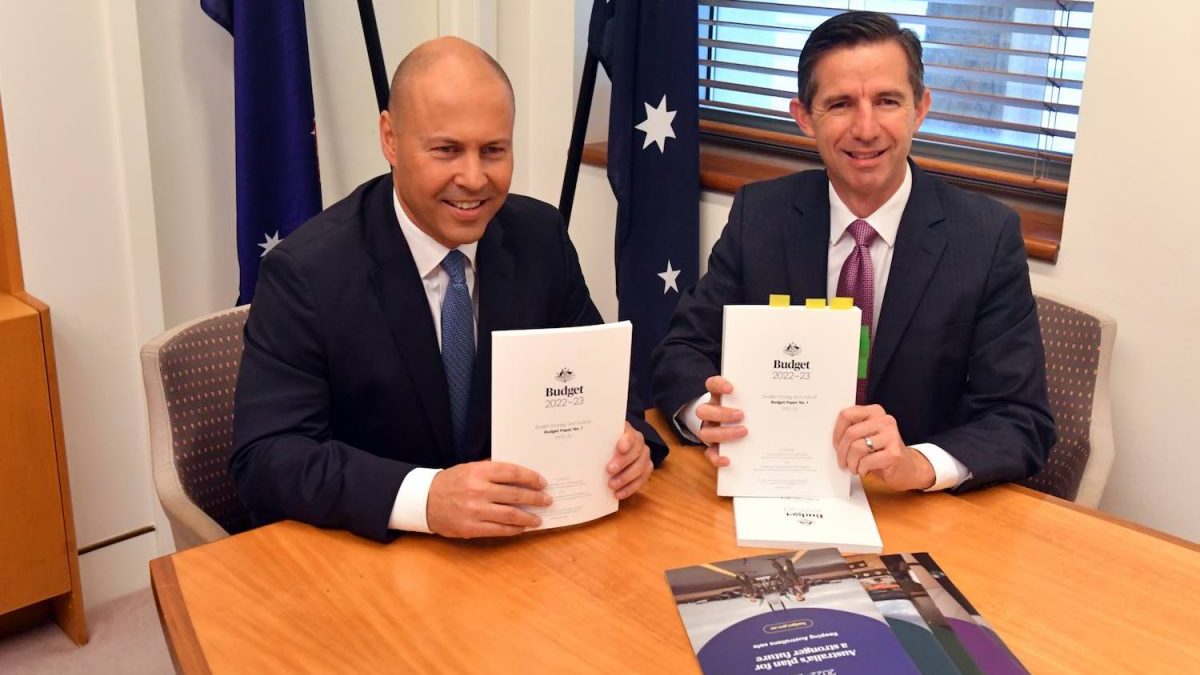The Morrison government has delivered yet another federal budget that offers virtually no new spending to tackle the threat of climate change, and fails to support increased uptake renewable energy or help Australia’s emerging electric vehicle industry.
In a pre-election budget, treasurer Josh Frydenberg focused on a range of tax cuts and “cost of living” sweeteners that the Morrison government is hoping might win over voters that have become growingly frustrated at a Morrison government that has mishandled a range of crises, including bushfires, the Covid-19 pandemic and floods.
The budget will see federal government spending on climate change measures decline each year for the next four years, just as the world faces a worsening threat posed by climate change and Australia faces mounting international pressure to pull its weight in global efforts to cut greenhouse gas emissions.
In his budget speech on Tuesday evening, Frydenberg made reference to climate change and pre-existing funding intiaitives, many of which were established under the previous Gillard government.
“Australia is on the pathway to net zero emissions by 2050 and playing its part in responding to the critical global challenge of climate change,” Frydenberg said on Tuesday night.
“Already, Australia has the highest uptake of rooftop solar in the world. We are investing in clean hydrogen, carbon capture and storage, batteries and large‑scale solar.”
“Tonight, we make further investments in microgrids to support regional and remote communities that don’t otherwise have access to the grid with small‑scale renewable energy projects like solar and wind,” Frydenberg said.
In fact, the budget papers show that federal government spending on climate change measures is set to fall over the next four years, falling 35 per cent from current levels by 2025-26, as the Morrison government continues to neglect climate change as an important issue.
Spending on climate change measures will drop from $2 billion in the current financial year to just $1.3 billion by 2025-26. This spending is mostly made up of existing funding for the Australian Renewable Energy Agency and the Clean Energy Finance Corporation.

The energy and emissions reduction portfolio attracted just a handful of new initiatives in the federal budget. These include:
- $247.1 million of largely recycled commitments to fund the development of unspecified “low emissions technologies” and the development of a federal hydrogen Guarantee of Origin scheme.
- $148.6 million will be provided over the next five years to support “affordable and reliable power,” around half of which will be directed towards the development of microgrid projects in regional and rural Australia.
- An already announced $50.3 million in subsidies for the gas industry, funding the construction of new pipelines and exploration for more gas reserves.
The Climate Council slammed the budget as a “massive missed opportunity”.
“Rather than investing in a green economic future, the Federal Government has used tonight’s Budget to toss mere pennies at genuine emissions reduction initiatives, such as the regional renewable microgrids,” the Climate Council’s Nicki Hutley said.
“At the same time, significant funds are being spent on so-called ‘low emissions hydrogen’ and the costly and unproven carbon capture and storage. And a further $50 million is being directed to accelerate polluting gas projects.”
The Winners
- The Gas Industry
The gas industry secured a further $50.3 million in funding, announced in the lead up to the budget, adding to the funds it has already received under the Morrison government’s ‘gas led recovery’, that will see more of Australia’s gas exported offshore.
To this end, an additional $300 million will be provided to support the development of a Darwin LNG processing and export facility.
- Petrol vehicles
The Morrison government will deliver on a widely anticipated cut to the federal fuel excise. The excise will be temporarily halved for a period of six months. It will reduce the excise charged on fuel sales by about 22 per litre, helping to make petrol cheaper for those driving petrol vehicles.
- Inventors
The Morrison government will extend its existing “patent box” scheme to low emissions technologies. The scheme provides a concessional taxation rate (17 per cent, down from a usual 30 per cent tax rate) on royalties received through recognised patents. The measure is expected to incentivise local research and development.
- The Resources Sector
The Morrison government will channel substantial funding into Australia’s resources industry, which it says will boost the production of “low emissions” materials.
This includes $200 million for Australian iron ore processing and $200 million for “low emissions” manufacturing of ammonia and carbon capture and storage projects in the Pilbara.
The Neglected
- Electric Vehicles
The 2022 federal budget includes no new measures to support the uptake of electric vehicles. As advocates and vehicle manufacturers continue to plead for more support to help electric vehicles gain a foothold in the Australian vehicle market, the sector has again been overlooked.
Anyone who says we can't afford – or that it's not good value for money – to subsidise electric vehicles, that would end our dependence on imported oil, needs to shut up.
— Behyad Jafari ⚡🚘 (@BJafari) March 29, 2022
- Renewable Energy
It will come as no surprise that the renewable energy sector has received no new support from the Morrison government under the 2022 federal budget.
There are no increases in support for the research and development of new renewable energy technologies – despite the Morrison government counting on unspecified advancements in yet unknown technologies to deliver its emissions reduction projections.
- Transmission Infrastructure
Australia has a massive opportunity to become a renewable energy superpower, but this vision will require significant investment in new network infrastructure. This would support the creation of new Renewable Energy Zones and massive new green energy export opportunities.
The budget has included $100 million to support new grid infrastructure in the Pilbara, but no further funding has been provided in the budget to help build new network links throughout the rest of the grid.










